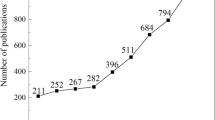More than 95% of hydrotechnical facilities (HFs) are part of a reclamation and water management complex. In most cases, their pressure front is formed by dams made of class IV soil materials, classified as low-hazard HFs with a standard service life of 50 years. After the economic crisis at the end of the last century, a large part of small HFs became abandoned or passed into the ownership of organizations having no qualified specialists in hydraulic engineering or maintenance services. The majority of such owners lack funds for maintenance and repair of these structures, including diagnostics of their technical condition. A significant part of these dams has reached or exceeded their standard service life. In this work, we carry out a probabilistic forecast of the safety level of earth dams that were commissioned during the period of intensive reclamation works. The forecast interval exceeds the period of standard service life. The research basis included the data obtained during expert estimation of the safety level of more than 1.5 thousand homogeneous low-hazard earth dams situated in the Moscow region. The research methodology involved the system theory of reliability and the theory of stochastic processes.
Similar content being viewed by others
References
I. Vaníèek, M. Vaníèek, D. Jirásko, and Pecival T., “Experiences from the small historical dams failures during heavy floods,” IOP Conf. Series: Earth and Environ. Sci., 26(1), 012042 (2015). https://doi.org/10.1088/1755-1315/26/1/012042
F. Escolano-Sanchez and R. Fernandez-Serrano, “Hazards caused by uncontrolled vegetation and inadequate maintenance practice in earth dams,” Technol. Cienc. Agua, 6(6), 137 – 144 (2015).
Y. M. Akhmetov, K. M. Assemov, and M. O. Zhumataeva, “Research of accidents of hydraulic structures and safety control methods,” Bull. Tomsk Polytechn. Univ. Geo Assets Eng., 331(4), 70 – 82 (2020). https://doi.org/10.18799/24131830/2020/4/2595
P. G. Schweiger, D. M. Temple, D. McCook, and A. J. Hess, “A look at earth spillway design and evaluation after more than 50 years of experience,” in: Proc. Association of State Dam Safety Officials Annu. Conf. “Dam Safety,” 2, 761 – 777 (2008).
F. Vahedifard, K. Madani, A. AghaKouchak, and S. K. Thota, “Preparing for proactive dam removal decisions,” Science, 369(6500), 150 (2020). https://doi.org/10.1126/science.abc9953
S.-M. Jun, M.-S. Kang, S. Hwang, J. Park, and J.-H. Song, “Flood vulnerability assessment for prioritizing and evaluating rehabilitation of ungauged reservoirs considering climate change,” Water, 12(7), 1901 (2020). https://doi.org/10.3390/w12071901
C. Wang, M. Beer, and B. M. Ayyub, “Time-dependent reliability of aging structures: overview of assessment methods,” ASCE-ASME J. Risk Uncertainty Eng. Syst. Part A. Civil Eng., 7(4), 03121003 (2021). https://doi.org/10.1061/ajrua6.0001176
C. Wang, “A stochastic process model for resistance deterioration of aging bridges,” Adv. Bridge Eng., 1, 3 (2020). https://doi.org/10.1186/s43251-020-00003-w
Y. Xu and L. Zhang, “Breaching parameters for earth and rock-fill dams,” J. Geotechn. Geoenviron. Eng., 135(12), 1957 – 1970 (2009). https://doi.org/10.1061/(ASCE)GT.1943-5606.0000162
E. Vanmarcke, “Multi-hazard risk assessment of civil infrastructure systems with a focus on long linear structures such as levees,” in: Proc. Int. Conf. on Sustainable Development of Critical Infrastructure (2014), pp. 37 – 56. https://doi.org/10.1061/9780784413470.003
H. Kreuzer and P. Léger, “The adjustable factor of safety: a reliability-based approach to assess the factor of safety for concrete dams,” Int. J. Hydropower Dams, 1, 85 – 88 (2013).
B. Juliastuti, C. Thoyibahri, O. Cahyono, and O. Setyandito, “Qualitative assessment of deterioration embankment dam using index condition and annual probability of failure (APF) using event tree method,” IOP Conf. Ser. Earth Environ. Sci., 794(1), 012060 (2021)
V. I. Volkov, V. L. Snezhko, and D. V. Kozlov, “Forecast of the safety level of low-pressure and ownerless hydraulic structures,” Gidrotekhn. Stroit., No. 11, 35 – 41 (2018).
T. Morimura, T. Osogami, and T. Idé, “Solving inverse problem of Markov chain with partial observations,” NIPS, August, 1655 – 1663 (2013).
S.-K. Au and J. L. Beck, “Estimation of small failure probabilities in high dimensions by subset simulation,” Probabil. Eng. Mech., 16(4), 263 – 277 (2001). https://doi.org/10.1016/S0266-8920(01)00019-4
T. C. Lee, G. G. Judge, and A. Zellner, Estimating the Parameters of the Markov Probability Model From Aggregate Time Series Data, North-Holland, Amsterdam – London (1970).
A. Tesselkin and V. Khabarov, “Estimation of origin-destination matrices based on Markov chains,” Proc. Eng., 178, 107 – 116 (2017). https://doi.org/10.1016/j.proeng.2017.01.071
G. Frigerio Porta, M. Bebbington, X. Xiao, and G. Jones, “Bayesian lifetime analysis for landslide dams,” Landslides, 17, 1835 – 1848 (2020). https://doi.org/10.1007/s10346-020-01388-5
J. Neyman, “Contribution to the theory of the χ2 test,” in: First Proc. Berkley Symposium in Math. Stat and Prob., University of California Press, Berkeley (1949), p. 239.
F. Pardo-Bosch and A. Aguado, “Investment priorities for the management of hydraulic structures,” Struct. Infrastruct. Eng., 11(10), 1338 – 1351 (2015). https://doi.org/10.1080/15732479.2014.964267
D. V. Kozlov, “Modern aspects of state regulation of hydraulic structures safety,” Prirodoobustroistvo, 3, 45 – 51 (2016).
Author information
Authors and Affiliations
Corresponding author
Additional information
Translated from Gidrotekhnicheskoe Stroitel’stvo, No. 9, September 2022, pp. 2 – 9. DOI: https://doi.org/10.34831/EP.2022.70.69.001
Rights and permissions
Springer Nature or its licensor (e.g. a society or other partner) holds exclusive rights to this article under a publishing agreement with the author(s) or other rightsholder(s); author self-archiving of the accepted manuscript version of this article is solely governed by the terms of such publishing agreement and applicable law.
About this article
Cite this article
Kozlov, D.V., Snezhko, V.L. & Simonovich, O.S. Safety Forecast for Low-Hazard Earth Dams Beyound their Standard Service Life. Power Technol Eng 56, 795–800 (2023). https://doi.org/10.1007/s10749-023-01589-7
Published:
Issue Date:
DOI: https://doi.org/10.1007/s10749-023-01589-7




